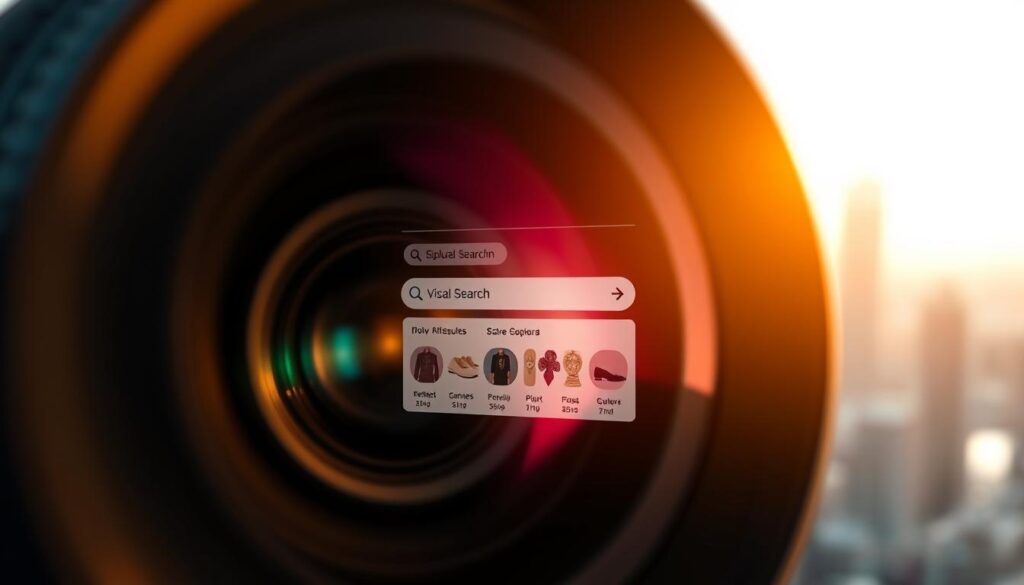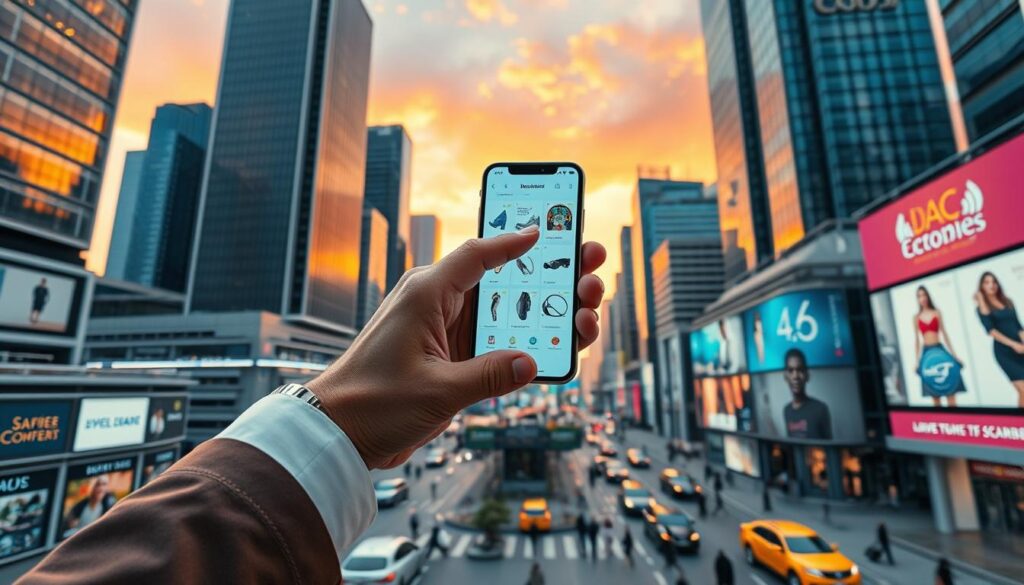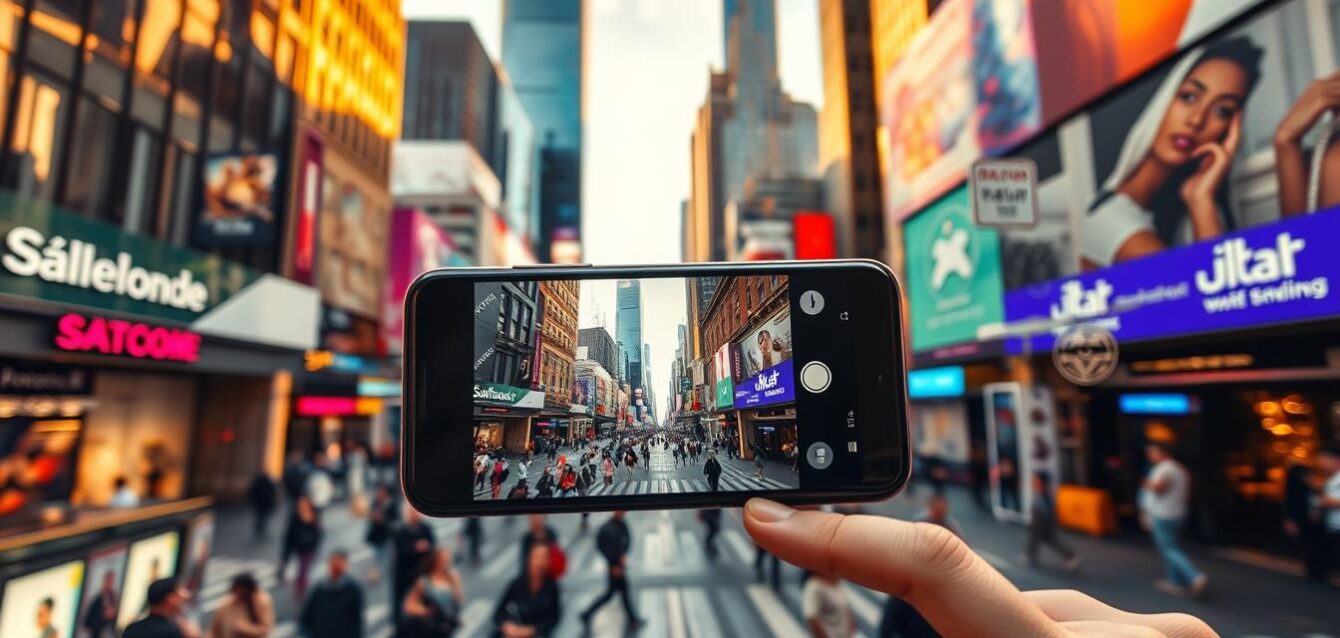Three billion monthly uses for Google Lens by 2021 proves the shift: your next buyer won’t type a query; they’ll tap the camera.
We believe a camera-first path to discovery is rewriting how high-intent users find products. When shopping begins with an image, checkout can happen twice as fast. That reduces friction and boosts conversion velocity for premium brands.
Brands like Target, IKEA, ASOS, and Neiman Marcus show measurable wins by linking in-store discovery to online commerce. Our approach blends platform data, real-world benchmarks, and a practical playbook so leaders can scale without overspending.
We will share the WebberXSuite™ methods and the A.C.E.S. Framework to integrate technology, content, and analytics into a single engine for growth. Act now to capture market share, harden attribution, and prove ROI.
Key Takeaways
- Camera-first discovery is driving faster paths to purchase and higher intent traffic.
- Google Lens usage and retailer case studies demonstrate scale and measurable results.
- Implementing shoppable media reduces steps to conversion and improves attribution.
- Our WebberXSuite™ and A.C.E.S. Framework map pilot-to-enterprise rollout with ROI guardrails.
- We position as your growth partner: strategic playbook plus operational tactics for premium businesses.
The new buyer journey is visual: why this shift matters now
Smartphones, better models, and endless photo feeds have shifted how people begin product discovery—from typing to tapping.
This matters for premium brands because aesthetic detail drives willingness to pay. More than 85% of online shoppers prefer visual information for categories like clothing and furniture. That preference lifts conversion when the first touch matches how buyers think.
Text-based queries add friction: vague terms, long pagination, and wasted ad spend inflate CAC. In contrast, visual search returns fewer, higher-fit results. The result is cleaner funnels and clearer attribution for high-ticket products.
Social media accelerates the shift. Discovery often starts in feeds where a single tap bridges inspiration to consideration using platform-native lenses and shoppable tools.
- Faster intent capture: camera inputs reduce cycles to checkout.
- Higher quality traffic: better matches mean lower churn.
- Engine impact: picture-derived signals improve ranking and recommendations.
| Metric | Text discovery | Camera-first discovery |
|---|---|---|
| Time to intent | Longer (keywords, pages) | Shorter (one tap, direct match) |
| Visitor quality | Lower, noisy | Higher, purchase-ready |
| Attribution clarity | Fragmented | Clearer, engine-friendly |
Visual search vs. image search: getting the definitions right
Defining terms now prevents costly misalignment when teams scope visual discovery projects.
We draw a clear line: visual search uses a photo as the query. The system analyzes pixels, not typed keywords, to find matches. By contrast, image search traditionally starts with words, file names, or URLs.

Reverse retrieval, metadata, and model basics
Reverse image retrieval converts an image into a vector. Convolutional neural networks on the back end map pixels to features. The engine then returns nearest neighbors—either similar images or similar items.
Metadata—color tags, shape attributes, and product labels—complements recognition. That hybrid approach improves results when a photo alone is ambiguous.
Where multimodal fits with text and voice
Multimodal workflows let a user start with a photo and refine with a short phrase or voice cue, avoiding the standard search bar restart. Example: upload a street-style jacket, then add “leather, black” to tighten matches.
- Governance: align product, marketing, and engineering on common KPIs.
- Practical payoff: faster intent capture and clearer attribution for premium brands.
Inside the tech: how computer vision, CNNs, and vector search power discovery
Behind every instant product match is a stack of models converting photos into actionable data. We translate pixels to commercial signals so leaders can measure impact directly against revenue.
From pixels to vectors: feature extraction, similarity, and clustering
Convolutional layers detect edges, textures, and shapes, then collapse those signals into numeric vectors. Those vectors enable nearest-neighbor matching and robust clustering for fast, relevant results.
Good training data and continuous learning ensure the model refines recognition as catalogs and trends evolve.
Avoiding underfitting and overfitting to protect relevance and ROI
Variety in image perspective and lighting prevents underfitting. Too much narrow data causes overfitting and brittle recommendations.
Our rule: monitor business KPIs—AOV, assisted conversions, and path-to-checkout velocity—before rolling large model changes.
Attribute detection, object cropping, and “Complete the Look” mechanics
Detecting color, silhouette, and pattern powers personalized recommendations and merchandising logic like Complete the Look.
Cropping focuses the query on a single object and yields sharper matches. Contextual cues—party vs. outdoors—tilt recommendations toward higher-converting assortments.
- Quality controls: preprocess noisy photos to stabilize recognition across devices.
- Governance: deploy category-specific models to reduce bias and scale safely.
Platform landscape: Google Lens, Bing, Pinterest Lens, Amazon, Snapchat, and eBay
Every marketplace and social app applies photo-driven matching differently; that difference shapes ROI. We map platform capabilities to enterprise goals so leaders pick the first lever that drives revenue.
Search engine integrations and use cases
Google Lens (2017) scales intent across Google properties and reached 3 billion monthly uses by 2021. It identifies objects, translates text, and surfaces product results that feed store and site traffic.
Bing Visual (relaunch 2018) offers desktop utility inside Edge and Windows for product comparison and landmark identification.

Social discovery meets checkout
Pinterest Lens keeps discovery within Pinterest. Shop the Look pins and the Shop tab move people from inspiration to checkout with tagged products and curated results.
From scan to cart
Amazon StyleSnap (2019) and Snapchat Scan (2019) focus on fashion and quick commerce. Snapchat adds barcode support and Amazon product cards to shorten the path from scan to cart. eBay’s Find It On eBay (2017) converts uploads into immediate marketplace matches for unique and vintage items.
“Choose the platform that aligns with category depth, audience, and your control over product assets.”
- Phased entry: activate Lens and Bing to capture broad intent while testing category coverage.
- Social play: use Pinterest for lifestyle and Snapchat for youth-led moments.
- Marketplace reach: evaluate Amazon and eBay where marketplace conversion matters most.
| Platform | Strength | Best for |
|---|---|---|
| Google Lens | Breadth across web | Brand discovery |
| Pinterest Lens | Inspirational feeds | Lifestyle conversion |
| Amazon / eBay | Commerce engine | Marketplace sales |
Shoppable posts on social media: turning inspiration into instant shopping
Turning editorial moments into commerce requires discipline across assets, tagging, and feed hygiene.
We deliver a tactical checklist that prioritizes conversion and protects the premium brand experience.
Instagram and Pinterest best practices for product tagging and feed quality
Operationalize tagging: ensure each product and variant has clean IDs, accurate pricing, and live stock status synced to your website.
Standardize content: consistent angles, lighting, and background choices plus lifestyle and studio blends. Write captions and alt that clarify what shoppers are looking at and why it matters.
- Tune feeds: map categories to platform taxonomies and refresh new-arrival assets daily.
- Exploit platform features: use Pinterest Shop the Look dots and Instagram product tags to reduce taps to cart.
- Boost intent capture: clear CTAs, mobile-first cropping, and thumb-stopping first frames.
- Protect experience: moderate mislabeled items and ensure creatives render crisply on high-density displays.
- Benchmark: track impressions-to-click rate, product view-through, and shoppable conversions by post.
| Checklist | Primary Benefit | Key KPI |
|---|---|---|
| Clean SKUs & sync | Zero broken journeys | Conversion rate |
| Content standards | Higher trust | Product view-through |
| Platform features | Fewer taps to cart | Impressions-to-click rate |
| Moderation & QA | Consistent experience | Return rate |
“Treat each post as a mini storefront — asset discipline wins at scale.”
Main growth levers: how Visual Search & Shoppable Images accelerate revenue
When we remove guesswork from product discovery, conversion velocity rises and marketing waste falls.
Speed-to-cart compresses dramatically with visual search. Studies show users can reach checkout up to twice as fast when they skip keyword trial-and-error and see relevant options immediately.
Shortened path to conversion and less ecommerce noise
Image-led results narrow assortments and cut pogo-sticking between irrelevant pages. That clarity raises conversion rates, especially for high-consideration categories like apparel and furniture.
Integrating online and offline: store-to-mobile-to-web experiences
A customer in a store takes a photo, finds the SKU or close alternatives online, and completes the purchase with delivery or ship-to-store. This protects revenue when stock is limited and extends lifetime value.
Capitalizing on social proof and word of mouth
When users identify a creator’s look, precise product matches turn influence into measurable sales. Recommendations and “Complete the Look” mechanics increase AOV without adding complexity.
- Quantified effects: faster intent capture, lower CAC, higher add-to-cart rates.
- Operational play: deploy Pinterest Lens for discovery, route matches to curated PDPs, measure uplift vs text-only journeys — a clear example for prioritization.
“Reduce taps, improve matches, and you convert inspiration into a predictable revenue stream.”
| Growth Lever | Business Impact | Metric |
|---|---|---|
| Speed-to-cart | Higher conversion velocity | Checkout time (−50%) |
| Omnichannel matches | Extended sell-through | Store-to-web orders (%) |
| Social proof conversion | Trackable influencer ROI | Referral-to-sale rate |
Optimization playbook: image SEO and content readiness for visual discovery
We standardize creative and data so catalogs perform in photo-driven channels and on your website. Our playbook ties technical SEO to measurable discovery outcomes.
Image quality, formats, dimensions, and site speed
Audit shoots for consistent lighting, angle, and background. Export JPEG for the best size-to-quality balance and use PNG only when transparency matters.
Cap dimensions for modern screens. Compress and lazy-load to keep page weight low and improve search surfaceability.
File names, alt text, captions, schema, and 360° assets
Use descriptive file names and concise alt text that help a real user and machines. Add captions that clarify key attributes.
Publish 360° spins and multiple views to reduce buyer uncertainty and lift conversion.
Product data hygiene: attributes, categories, and consistent tagging
Normalize color, material, and silhouette. Keep feeds synced to platforms like Pinterest Business and Shopify so catalog results stay accurate.
| Asset | Best format | Load impact | SEO benefit |
|---|---|---|---|
| Hero photo | JPEG | Medium | Faster indexation |
| Transparent graphic | PNG | Higher | Better presentation |
| 360° spin | WebP / optimized GIF | Variable | Higher confidence |
“Asset discipline reduces friction and improves ranking—both for users and engines.”
- Implement: normalize pipelines, semantic tags, and responsive delivery.
- Audit: measure shifts in search results, CTR, and time-to-first-add-to-cart.
- Ensure: alt text aids accessibility and E-E-A-T through accurate structured data.
From test to scale: build vs. buy and a phased implementation roadmap
Start with platforms where demand already exists and use that data to guide native builds.
We recommend partnering first with Google Lens and Pinterest Lens to validate category-level demand. These platforms let us collect real user search signals and rapid learning without heavy engineering spend.
Pilot scope and success criteria
Keep pilots tight: 1–2 high-margin categories, four-to-eight weeks. Track match rate, CTR, add-to-cart, conversion, AOV, and assisted revenue.
Change management and operational readiness
- Align teams: product, engineering, merchandising, and CX on workflows.
- Prepare the store stack: PIM/DAM hygiene, CDN performance, analytics instrumentation.
- Support: train service teams for image-led journeys and new returns flows.
“Partner first to prove demand; build only when the economics and data favor ownership.”
| Approach | Speed | Control | Cost to start |
|---|---|---|---|
| Platform leverage (Google / Pinterest) | Fast | Medium | Low |
| Native engine (vector / custom) | Slower | High | Higher |
| Hybrid (API + owned index) | Moderate | High | Moderate |
Roadmap: launch upload and camera capture, add cropping and attribute tagging, then roll out “Complete the Look” and contextual recommendations. Bake governance into every phase: privacy reviews, bias audits, and rollback plans.
Measurement that matters: analytics and KPIs for visual shopping
Executives need a concise metrics framework that converts product-level behavior into dollars. We build reporting that ties UX signals to revenue and margin so leaders can act with confidence.
Attribution, assisted conversions, and path-to-checkout velocity
Trackable events begin with a single photo-driven inquiry and end at purchase. We log clicks on search results, styles examined, and purchases tied to the initiating search.
- Core KPIs: initiation rate, match rate, CTR from results, add-to-cart rate, conversion rate, path-to-checkout time.
- Assisted conversions: attribute influence when a session begins with a photo and converts later through other channels.
- UX signals: heatmaps on cropping, filter use, and drop-off points to isolate friction.
Category-level insights: what styles and items convert
We segment by category to reveal which items over-index on conversion. That data informs merchandising, content, and creative refresh cycles.
| Insight | Action | Metric |
|---|---|---|
| High-match styles | Invest in hero content & inventory | Conversion uplift (%) |
| Low-match gaps | Enrich attributes & imagery | Match rate |
| Feature experiments | Compare models and content cycles | CTR / AOV |
“Measurement must feed optimization—fast.”
We deliver weekly snapshots and monthly deep dives so C-suite reporting links changes in features and content to measurable revenue. Then we close the loop: optimize, retrain, and scale.
Real-world examples: how retailers are winning with visual search
Leading retailers have turned photo-led discovery into measurable revenue gains across categories. We examine four examples that translate to clear playbook moves for premium brands.
Target — partner-first expansion
Target integrated Pinterest Lens so in-store shoppers could snap a product and see similar items outside aisle constraints. The approach proved that partnerships expand choice without heavy engineering.
Best practice: prioritize platform leverage to broaden assortment and remove reliance on the search bar.
IKEA — AR meets practical merchandising
IKEA added recognition to its Place AR app so a customer can take a photo of furniture and find matching SKUs for the home. The result: higher confidence and fewer returns.
Best practice: pair AR with category-fit tools to make inspiration actionable.
ASOS — mobile-first, instant matches
ASOS StyleMatch lets shoppers snap or upload a photo and get exact or similar items fast. Their app-led execution captured the bulk of fashion buyers and boosted loyalty.
Best practice: meet customers where they shop—mobile experiences must be fast and frictionless.
Neiman Marcus — start narrow, scale fast
Neiman Marcus began with women’s shoes and handbags, proved uplift, then expanded. This phased rollout reduced risk and secured stakeholder buy-in.
Best practice: validate with tight pilots and scale on measured wins.
“Turn inspiration into a measurable path to purchase: prioritize category readiness, pick the right partner, and align content to how people take photos.”
- Measurement: tie each deployment to match rate, add-to-cart, and conversion deltas.
- Content: keep high-quality assets so matches are accurate and returns fall.
- Competitive edge: faster paths from inspiration to cart beat rivals.
Risks, governance, and UX pitfalls to avoid
When recognition systems fail, user trust and revenue fall — and recovery is costly. We confront risk directly and prescribe controls that leaders can enforce.
Data quality drives commercial outcomes. Poor labels, low-resolution assets, and limited perspectives produce noisy model outputs and weak matches. Overfitting or underfitting harms relevance and erodes confidence in results.
We enforce governance with QA gates, escalation paths, and a single source of truth for product metadata. Mislabeled items must be corrected before retraining. Schedule regular audits to prevent model drift and refresh training sets for seasonality and new collections.
Bias, data hygiene, and trust
Mitigate bias by curating diverse training sets and testing across skin tones, styles, and object types. Track fairness metrics and act on disparities.
UX controls: facets, related searches, and cropping
Apply facets to narrow results and related searches to guide exploration. Offer cropping tools so users can isolate the intended object and reduce false positives.
- Privacy & security: define upload, retention, and deletion policies that comply with regulations.
- Error states: when confidence is low, suggest retry options—alternate angles or clearer lighting.
- Decision rights: document roles for legal, product, and brand teams to approve responses when systems fail.
“Treat governance as a product feature: it protects brand equity and ensures predictable revenue.”
What’s next: present-day trends shaping visual commerce
The next phase of product discovery blends pictures, short prompts, and spoken cues into a single user flow.
Multimodal by default: we expect image plus a brief phrase or voice cue to be standard. This reduces ambiguity and speeds intent to purchase.
Mobile as primary surface: invest in camera-first UX, instant capture feedback, and fast pipelines. Brands like IKEA and Sephora have already proven mobile-led capture drives engagement.
Richer context and AR: object detection and AR will add placement and fit guidance, especially for home and fashion. Vector and hybrid engine models will improve multi-object recognition and relevance.
Ethics and analytics: we must suggest eco-friendly options and modernize event models that tie discovery across channels to revenue. That ensures trust and measurable ROI.
“Build modular stacks and upskill teams so technology turns into business outcomes.”
| Trend | Roadmap Action | Business Impact |
|---|---|---|
| Multimodal interfaces | Prototype image+text/voice capture | Faster intent, fewer false matches |
| Mobile-first capture | Optimize camera UX and latency | Higher conversion on phones |
| AR + object detection | Integrate placement tools for home/fashion | Lower returns, higher confidence |
| Ethical recommendations | Tag sustainable SKUs in feeds | Brand trust, repeat purchase |
Conclusion
Leaders who act now convert inspiration into measurable revenue and market share.
We’ve shown how visual search turns intent into purchases — compressing discovery, clarifying choices, and elevating the customer experience premium buyers expect.
Retail proofs—from Target on Pinterest Lens to IKEA’s AR, ASOS StyleMatch, and Neiman Marcus’ phased rollouts—demonstrate faster paths to checkout and clearer measurement. Google Lens handles billions of queries, proving demand at scale.
Act decisively: access Macro Webber’s Growth Blueprint to map a category plan in 14 days, or book a strategy consultation to architect your rollout. We deploy WebberXSuite™ and the A.C.E.S. Framework to align teams, tech, and content into a single revenue engine.
Own the new search box or watch others take your edge.



